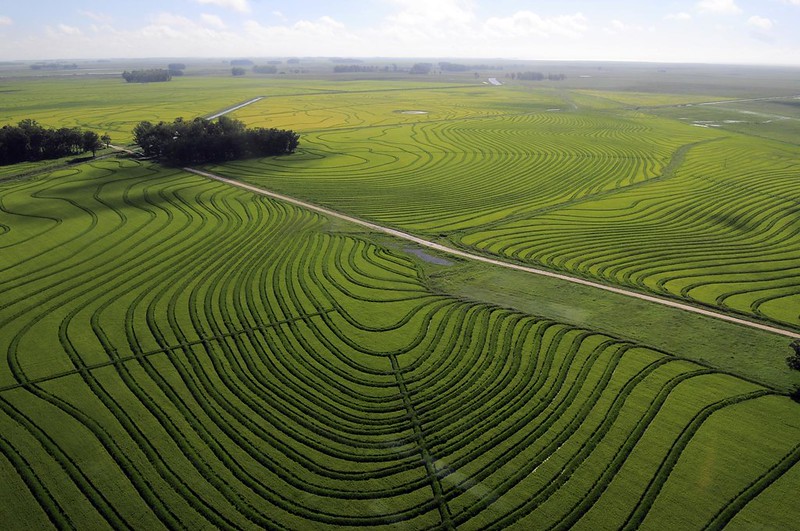Improved Rice Production
Rice production, a staple for over half the world's population, can benefit significantly from sustainable farming methods. Innovations in rice cultivation can enhance yields, reduce greenhouse gas emissions, and improve soil health.

Rice production in Eastern Uruguay
Image credit: © 2012CIAT/NeilPalmer via Flickr
View open jobs in this Solution
Example Companies
- International Rice Research Institute (IRRI) - Pioneers advanced rice cultivation techniques.
- Golden Rice Project - Develops biofortified rice to address vitamin A deficiency.
- Olam International - Implements sustainable rice farming practices globally.
- Syngenta - Provides innovative crop protection and seed solutions.
- Bayer Crop Science - Develops sustainable agriculture technologies for rice production.
Overview
The Green Revolution significantly boosted food production through agricultural advancements such as fertilizers, pesticides, and irrigation methods. However, these techniques led to environmental issues like soil degradation and water contamination. Sustainable rice production methods, such as no-till farming, can reduce carbon emissions and maintain soil health. The International Rice Research Institute (IRRI) plays a crucial role in pioneering advanced rice cultivation techniques, including precision farming and organic fertilizer application.
- The State of Food and Agriculture - FAO
- Sustainable Rice Platform - Promotes sustainable rice production practices.
- Rice Today Magazine - Provides updates on rice research and innovations.
Progress Made
Significant advancements have been made in rice production:
- Improved Seed Varieties: High-yield, environment-resilient rice strains optimize production and cut greenhouse gas emissions.
- Water Management: Water-efficient irrigation techniques reduce water wastage and the overall water footprint of rice cultivation.
- Fertilizer Management: Effective fertilizer management strategies optimize fertilizer use and reduce related emissions.
- Crop Rotation: Innovative crop rotations that incorporate rice reduce emissions and enrich the soil.
- Pest Management: Environment-friendly pest management minimizes the use of harmful chemicals, reducing pollution.
The biggest benchmark from Speed & Scale
Reduce methane and nitrous oxide from rice farming by 50% by 2050. ↓ 0.5 Gt of reductions
Use their news tracking tool to track progress
Solutions by Sector
Seed Varieties
- High-Yield Varieties: Developing rice strains that produce higher yields under various environmental conditions.
- Drought-Resistant Varieties: Breeding rice that can withstand periods of drought.
- Biofortified Varieties: Enhancing the nutritional content of rice to address micronutrient deficiencies.
Case Studies:
- IRRI's Golden Rice: Biofortified rice to combat vitamin A deficiency (Golden Rice Project).
- Syngenta's Hybrid Rice: High-yield hybrid rice varieties for improved productivity (Syngenta).
- Bayer's Arize Hybrid Rice: Drought-resistant and high-yield hybrid rice (Bayer Crop Science).
Water Management
- Alternate Wetting and Drying (AWD): Reducing water use and methane emissions by periodically drying fields.
- Drip Irrigation: Efficient water delivery directly to the plant roots.
- Rainwater Harvesting: Collecting and storing rainwater for irrigation purposes.
Case Studies:
- Olam's Water Management Practices: Implementing AWD and other water-saving techniques in rice farming (Olam International).
- IRRI's Water-Saving Technologies: Promoting AWD and other water-efficient practices (IRRI).
- FAO's Water-Efficient Rice Project: Implementing water-saving practices in rice cultivation (FAO).
Sustainable Farming Practices
- No-Till Farming: Reducing soil disturbance to maintain soil health and reduce emissions.
- Organic Fertilizers: Using natural fertilizers to improve soil fertility and reduce chemical use.
- Integrated Pest Management (IPM): Combining biological, cultural, and chemical methods to manage pests sustainably.
Case Studies:
- Sustainable Rice Platform's Standards: Promoting sustainable farming practices among rice farmers (Sustainable Rice Platform).
- Olam's Organic Fertilizer Programs: Implementing organic fertilizer use in rice farming (Olam International).
- IRRI's IPM Programs: Developing and promoting IPM techniques for rice (IRRI).
Lessons Learned
- Proper Implementation: Technology must be properly designed and implemented to be effective.
- Learning from Failures: Failures often result from incorrect implementation rather than the technology itself.
- Stakeholder Involvement: Engaging all stakeholders, including farmers, scientists, and policymakers, is essential for success.
- Continuous Improvement: Ongoing research and adaptation are necessary to refine techniques and address challenges.
Challenges Ahead
- Yield Enhancement: Increasing rice yields to feed the growing global population.
- Water Usage: Reducing the water intensity of rice cultivation.
- Reducing Chemical Dependency: Minimizing the use of fertilizers and pesticides to mitigate environmental impact.
- Climate Resilience: Developing rice varieties and farming practices that can withstand changing climate conditions.
Best Path Forward
- Research and Development: Continued investment in technology advancement is essential.
- Educate Farmers: Empowering farmers with knowledge of new techniques and their benefits is pivotal.
- Provide Incentives: Encourage farmers to embrace sustainable methods through financial incentives.
- Policy Support: Implement supportive policies and regulations to promote sustainable rice production.
- Global Collaboration: Foster international cooperation to share knowledge and best practices.
Image credit: © 2012CIAT/NeilPalmer via Flickr